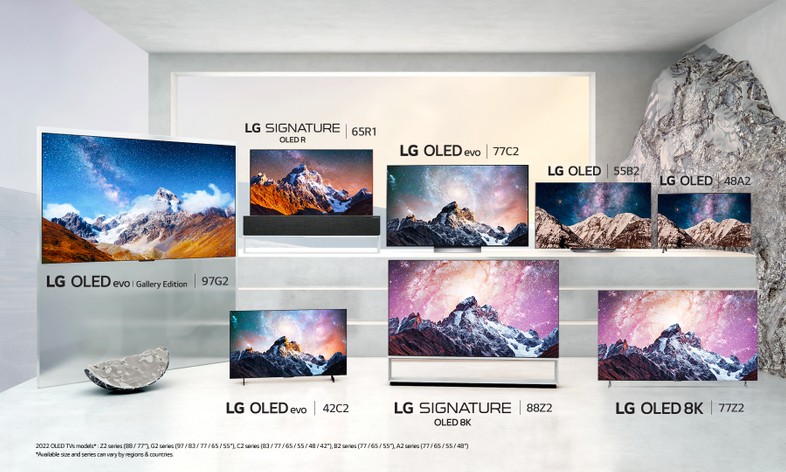LG’s new C2 and G2 series OLED TVs will not feature OLED.EX technology, announced by LG Display (the division that produces the panels) a few days before the opening of CES 2022. The news was confirmed to us by LG Italia which has therefore chosen to carry out a very transparent communication. C2 and G2 will feature OLED Evo technology, the same technology that debuted last year on the G1 series.
In this article, we want to provide an overview of the two technologies, OLED Evo and OLED.EX, highlighting their benefits and comparing their respective performances as far as possible (for OLED.EX we do not yet have instrumental measurements), to provide a comprehensive picture of what we can expect from the televisions coming out in 2022.
SUMMARY
OLED EVO TECHNOLOGY

OLED Evo is the first real evolutionary step introduced by LG after the debut of WRGB TVs in 2013. It should be remembered that the wording “OLED Evo” does not refer only to the panels but to one synergy created by the innovations introduced on the screens and by the optimization made by the Alpha 9 processors. The events are therefore a solution proposed only by LG, precisely because only the models of the Korean giant have electronics developed internally. Of course, there are OLEDs from other brands equipped with the same panels which, however, are flanked by different processors.
As for the panels, the OLED Evos have modified the organic materials through targeted interventions on various emitters. We speak specifically of changes to blue and red emitters and adding a substrate with green emitters. These improvements have resulted in a purer light. By examining the wavelength of the blue emitters, there is a higher peak and a reduction in the spectrum of 42% (the narrower the wavelength, the purer the light). For the red emitters, the reduction is 33% while for the green ones 23%. The average thus stands at 32% and translates to one superior luminous efficiency compared to previous OLED panels.
The Alpha 9 processors intervene based on all these changes to better manage the panels, making use of this greater reserve to increase luminance both in SDR (Standard Dynamic Range: everything that is not HDR) and in HDR. The measurements we carried out on the CX OLEDs (2020 without OLED Evo technology) and the G1 OLEDs (2021 with Evo technology) confirmed the increase.
Below we report comparison on the most relevant aspects
OLED CX
- Long-term sustained luminance peak on white at 100% in SDR: A little bit more than 140 cd / m² – nit
- Peak luminance in HDR on white at 2%: approx 770 cd / m² – nit
- Peak luminance in HDR on white at 10%: approx 760 cd / m² – nit
OLED Evo G1
- Long-term sustained luminance peak on white at 100% in SDR: A little bit more than 160 cd / m² – nit
- Peak luminance in HDR on white at 2%: approx 850 cd / m² – nit
- Peak luminance in HDR on white at 10%: approx 830 cd / m² – nit
As you can see, the greatest advantages are recorded with sustained brightness on the entire screen in SDR, where the increase can reach values not far from 20% more, the improvement that the OLED Evo theoretically had to bring according to the advances circulated before the exit. In HDR, the increase is especially noticeable in the smaller portions of the screen, those on which the “specular highlights” usually focus, ie all those small details on which the action of the high dynamic range usually focuses. On average, the increase does not exceed about 10%.
THE OLED.EX TECHNOLOGY
On December 29, 2021, LG Display announced the next evolution of the OLED Evo: the OLED.EX. “EX” is the acronym of “Evolution” and “eXperience”, two words chosen to clarify the objective pursued with the new technology: to provide consumers with new experiences through the continuous evolution of OLED screens. The improvements made concern again the organic components and the electronics. As for the former, LG Display said it used for the first time organic elements in deuterium instead of those based on hydrogen.
The characteristics of deuterium allow obtaining two benefits: one luminance that grows up to 30% more, compared to a conventional OLED, and high efficiency in the long run. As on the OLED Evos, the processors optimize these improvements. L’artificial intelligence (AI), specifically “machine learning” (here we provide a dedicated study), applies various algorithms specially developed to obtain greater control over the OLED.EX panels. The electronics can evaluate in advance how the self-emitting pixels will be used, learning the individual vision screens.
In this way, the AI can handle the power supply for luminance peaks more effectively, to take full advantage of the improvements made to the panels. LG Display claims that this feature results in greater accuracy in reproducing the colors and all the details present in the source. Lastly, OLED.EX also has an improved design thanks to thinner bezels; it goes from 6 to 4 millimeters on a 65 “TV, about 30% less.
OLED EVO VS OLED.EX
The use of OLED Evo technology on C2 and G2 TVs did not take us by surprise. The reason is contained in the press release released by LG Display which reads as follows:
LG Display plans to strengthen its leadership and competitiveness in the large OLED market by integrating OLED.EX technology into all OLED TV screens manufactured at the factories in Paju, South Korea, and Guangzhou, China. starting from the second quarter of 2022.
As you can easily guess, starting the production of the new panels in the second quarter of the year would not allow bringing the TVs to market in the necessary time, since usually the first products are launched between March and April. The first screens were updated with the improvements of the OLED.EX would be available practically concurrently with the launch of the OLED 2022 range: therefore there would not be enough time to assemble the TVs (which do not include only the OLED panels) and ship them to stores in quantity.
Unless LG decides to launch other models later in the year (but not recently), in 2022 the OLED Evo will still represent the maximum expression of the WRGB technology developed by the Korean brand. At this point, however, it is good to fix some points to frame the relationship between OLED Evo and OLED.EX in the right perspectives.
The first point to consider is the increase in luminance. As we reported in the chapter on OLED.EX, LG Display talks about an increase of up to 30%. Here it is important to consider the term of comparison: up to 30% more luminance than what? To a conventional OLED. Conventional OLEDs are all those that do not have the OLED Evo technology.
So how are the OLED Evo positioned compared to the OLED?EX? At CES 2021 LG Display announced improvements to the 77 “TV panels, mentioning new organic components and the addition of a new substrate, characteristics that match those of the panels used on the OLED Evo. Thanks to these interventions there was talk of a ‘luminous efficiency increased by about 20%. This value is more or less corresponding to the increase that we have reported for the white peak at 100% in SDR on the G1.
So if the OLED Evos have already increased efficiency by up to 20%, this means that OLED.EX promises a further improvement of up to about 10%. On a peak of 830 – 850 cd / m² – nit, measured on an OLED Evo G1, the advantage of the OLED.EX would translate into 80 cd / m² – nit or slightly more. Finally, we come to the products that we will see in the course of 2022: on the C2 series, the OLED Evo technology arrives this year, after debuting on the G1 in 2021. Precisely for this reason, it was really difficult to think of a leap from conventional OLED to OLED.EX, without any intermediate step. LG Display’s announcement indeed points to the integration of enhancements across all panels produced in the second quarter, but it’s a statement that shouldn’t be read so literally.
From a certain period onwards the panels may be all updated without this implying an immediate change in performance on the series already on the market: we remind you that the announced benefits also require the contribution of the electronics and that in any case an OLED TV does not it is composed of a single panel but of multiple elements such as the T-CON, that is the circuit that controls the screen, the color filters, the power supply section, etc.
The ideal candidate for the adoption of OLED.EX technology is not so much the C series as the G series. On the G2 the transition would have been the natural continuation of the technological progress carried out by LG, only postponed for a matter of time. However, the use of OLED Evo must not be misleading: even without OLED.EX the G2s bring an important change compared to their predecessors. We refer to the technology Brightness Booster which is introduced on the new G. Brightness Booster series combines two innovations: as on the OLED.EX, artificial intelligence is used to analyze the images and apply a series of algorithms useful to further raise the luminance peaks where needed.
The second innovative element is constituted by materials and design elements that act as heat sinks. In practice, LG has followed in the footsteps of Sony (A90J) and Panasonic (all OLED xZ2000) and has added a system to dispose of heat more effectively. This change is very useful because it should allow you to reach and maintain (not for very short moments) higher luminance peaks. The containment of heat also brings benefits to image retention: an OLED that operates at lower temperatures tends to maintain higher efficiency in the long term; in other words, it can be said that organic emitters tend to age more slowly.
CONCLUSIONS
With this special, we have tried to clarify the news announced at CES 2022 and in the days immediately preceding it. Thanks to the confirmations of LG Italia we have put in perspective all the products coming this year and the technological evolutions presented by LG Display, which, we remind you once again, does not market televisions but manufactures and sells panels.
The timing of LG Electronics and LG Display does not always go hand in hand, as also demonstrated at CES 2021, where LG Display had communicated the arrival of the 42 “OLEDs. As we know, the 42” panels were produced starting from 2021, but the finished products, in the form of complete televisions, will arrive in stores only in the course of 2022.
The discrepancy between the announcement of the OLED.EX technology and its adoption on TV is therefore not surprising and neither should it attract particular attention from users. It is simply the natural evolution of technology that, as almost always happens, proceeds step by step. For the 2022 range, the innovations are the introduction of OLED Evo technology on the C2 series and the addition of Brightness Booster on the G2 series, in addition to all the refinements made through the electronics with the Alpha 9 Gen 5 processors.



